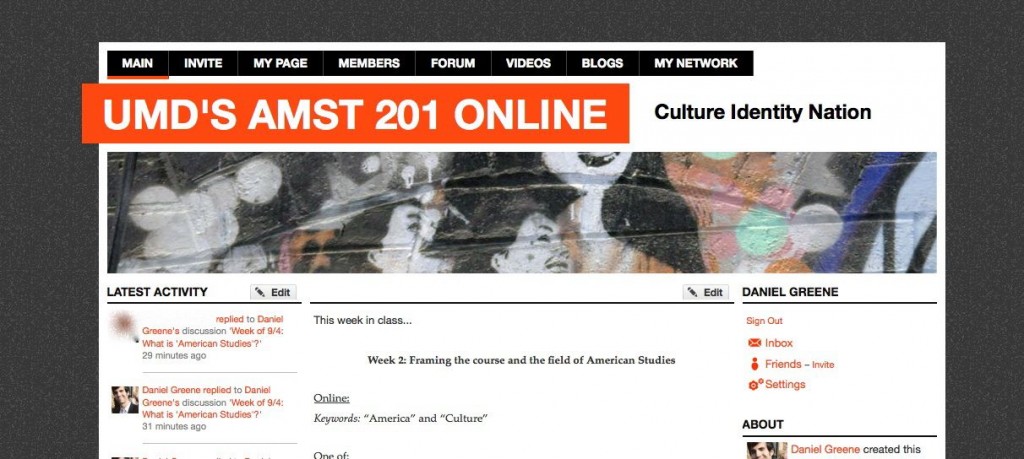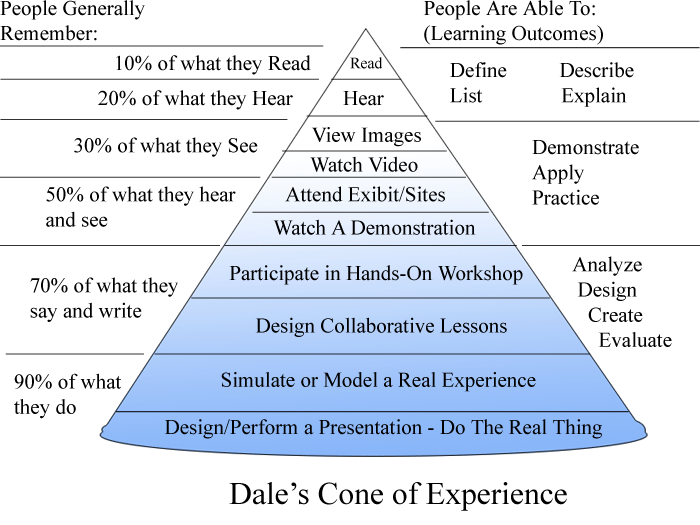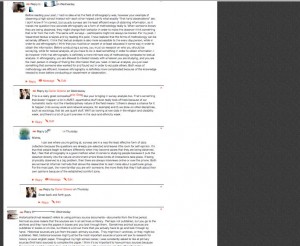
The research and writing featured on this blog generally build from the idea that digital information and material experience do not exist in two separate realities à la The Matrix, but coexist in one augmented reality where the informational and material play a role in constituting one another. This semester at the University of Maryland, I’m exploring those moves between informational spaces and physical ones in a mixed online and in-person version of an American Studies course and wanted to share and get feedback on the process of planning, designing, and enacting this augmented introduction to the study of American culture. This design is specific to this course and its themes, but the general principles should work elsewhere and the cultural context of online higher education is important to anyone involved with that system.
Online education is playing a larger and larger role in the economics and pedagogies of the increasingly privatized and ‘right-sized’ U.S. research university and my course is certainly a product of these changes. At the same time, researchers and teachers in a variety of disciplines are using this moment of transition to question and revise outdated pedagogical routines and are designing classes to better facilitate multiple levels of student engagement with reference to the real world outside the ivory tower. I would have loved to have explored interventions such as contract grading or an increased focus on navigating and designing information systems within my course but, like many graduate students, I had to work within the boundaries of an already existing syllabus. The general shape of the course was set; so my pre-semester work become more about adjusting the course’s weaknesses and flexing its strengths within the mixed online/in-person environment, knowing that the different parts of that environment would lend themselves to different kinds of learning. I organized this effort around a few core principles that apply in any learning environment:
- The classroom is a ‘community of practice‘ with multiple stakeholders. Everyone will not contribute at the same level or in the same way, but everyone has similar interests and goals.
- All activities and readings in every part of the course had to work towards the overall goals of engagement with American cultural studies, and the application of that new frame to themes of everyday life and identity.
- Everyone is more motivated, and learning is deeper and more persistent, when they are actively involved with class work and when that work is related to their everyday lives (e.g., less lecturing).
Introduction to American Stuies and American Culture serves as both the introductory course to the American Studies major and a Humanities credit for UMD’s CORE requirements. This places a premium on accessibility and interdisciplinary engagement. Students learn the history of the discipline, research and apply its major methodologies, and become familiar with major themes such as social construction, the formation and limits of nation, and aspects of identity such as race, class, and gender. Reviewing old syllabi and speaking with instructors who previously worked in the mixed format, I heard both structural (e.g., lack of engagement on Blackboard due to interface issues and frequent outages, little sense of student community) and content-level complaints (e.g., no clear links from week to week, an emphasis on theoretical ‘jargon’ that precluded real-world engagement). I felt a redesign of the online aspect of the class, integrating with but not mirroring the in-class component, would be able to answer a lot of these issues.
Step one was minimizing Blackboard’s presence in our class. I use it only as a storehouse for PDFs of copyrighted material. There are plenty of detailed reviews of Blackboard’s faults and biases elsewhere, suffice to say does 500 things andnone of them particularly well. For a group of freshmen trying to share and reflect on deeply personal issues of politics and identity, I wanted the online space to have a more personal feel and a design that focused on discussion and sharing of found materials. I was especially concerned that students, given that they were only seeing each other face-to-face once a week, would have a safe space where they felt comfortable sharing multiple forms of reflection on the syllabus’ issues with each other. Following a demo from American Studies faculty member Dr. Jo Paoletti [@joyomama] I turned to Ning, a make-your-own-social-network service that included profile pictures for each student, their own dedicated blog, a forum space that I could format for each week’s needs, and an activity feed that mirrored Facebook’s—only with transparency. Knowing such transparency was key to productive, engaged classes, I tried to explain the workflow and my reasoning behind it in detail in the syllabus.
So here’s how it works:
Students leave the 75-minute class on Friday and soon after receive a brief email from me with thoughts from the week, connections to past and future weeks, and a link to that day’s Prezi if there is one. After that I grade contribution for the week, update the course site’s landing page with the next week of the syllabus, and upload a ten to twenty-five minute podcast that answers leftover questions from class and outlines how next week’s activities fit in with the big picture themes of the course. Online work generally consists of a set of brief, technical readings from Keywords for American Cultural Studies; a set of media (e.g., journalism, short stories, or films) that apply or relate to that week’s themes, a weekly, focused 250-word forum post answering a prompt of mine; and a like-sized response to someone else’s post. I comment on everyone’s posts at least once, trying to critique and compliment everyone’s style and content and stress big-picture links such as social construction, structural versus individual cultural moves, and multiple experiences of ‘America’ that include subjugated knowledges and critical histories. A week’s discussion usually runs 75 to 100 posts between 16 students and myself, so there’s a fair amount of back-and-forth. For class Friday, students read more scholarly writing and together we discuss how those methodologies work with the week’s themes and major local, national, and transnational sociopolitical events or trends.
This week—“Reproducing Capitalism and Class”—looks like this:
Week 5: Reproducing Capitalism and Class
Online
- Keywords “Capitalism”, “Class”, and “Liberalism”
Watch the entirety of either:
- The Status Films https://www.facebook.com/pages/The-Status-Films/188879754457688?sk=info
- or Class Dismissed http://www.youtube.com/watch?v=gVu6ojB-cMg
Read:
- The first and last entries of Slate’s “The United States of Inequality” series, plus one other entry of your choice. http://www.slate.com/id/2266025/entry/2266026/
- Becker, Elizabeth, Clifford Krauss, and Tim Weiner. “Free Trade Accord at Age 10—The Growing Pains are Clear.” New York Times December 27, 2003. http://www.nytimes.com/2003/12/27/world/free-trade-accord-at-age-10-the-growing-pains-are-clear.html?scp=5&sq=maquiladora&st=cse&pagewanted=1
Answer:
- Why is ‘class’ important to the study of everyday life in culture?
- How has ‘class’ (and/or the systems that reproduce ‘class’) in American culture changed in the last 20 years?
In Class 9/30:
- Harman, Chris. “Introduction” through “How Capitalism Began” in How Marxism Works. London: Bookmarks, 1979. 4-20 in the .doc.
- Marx, Karl. “Wage Labour and Capital” (1847) http://www.marxists.org/archive/marx/works/1847/wage-labour/index.htm
- Bourdieu, Pierre. “The Forms of Capital” trans. Richard Nice in Handbook of Theory of Research for the Sociology of Education, J.E. Richardson ed. Greenwood Press, 1986. 241-58.
The general idea is that students use the theory of American Studies to frame a discussion relating to their everyday lives early in the week. They get comfortable with applying the week’s themes—and develop their writing—before we use the co-present back-and-forth of the classroom to zero-in on the mechanics and critiques of the more difficult scholarly readings. Offline and online complement each other by encouraging different kinds of critique on different kinds of texts, different self-reflexive conversations, and different modes of cultural ‘listening’. Major assignments include the introductory self-critique in an “American Me” essay posted online for other students to read, a writing-centric midterm, a long-form critique of a cultural ‘text’ (e.g., political campaign, TV series, food tradition), and a final group presentation that guides the rest of the class through a community problem and possible solutions to it as suggested by the semester’s work.

So far I’ve been encouraged by the back-and-forth conversations on Ning, and the cautious embrace of both charged issues—such as the intersection of nation and Native American genocide—and the hard work of self-critique—such as the economics of the Freshman Connections program my students are all enrolled in. There’s also been early problems that range from typical issues around freshman figuring out university protocol to motivating students to engage in other parts of community building (e.g., posting relevant videos or news links to keep debate current). As with managing any community of practice, I’ll want to reassess how things are working online and off—from interface to addressing political currents—and collect feedback from my students and from you all, if you don’t mind, at the mid- and end-points of the semester.



Comments 3
Dave Paul Strohecker — September 27, 2011
Wow. You are truly the TA I never was. Great use of new technologies. I haven't been able to get on board with Prezi yet, but my roommate loves it. I should probably convert. And Ning? I have never even heard of it. Thanks so much for these great resources! I will definitely use this as a guide next semester!
Dan Greene — September 27, 2011
Thanks David, really appreciate it. You're in sociology right? AMST at UMD is a small department with big enrollment, so GAs have--I think--more operational freedom at the day-to-day level than might be the case in larger departments. With that said, there's still a lot of big-picture changes I'd make, given the freedom.
Prezi is good for description, for mapping diverse concepts, and for working with media. I'm still learning it, but a bad Prezi is nauseating, compared to a bad PowerPoint which is just boring. PowerPoint is still better, I think, for telling narratives or doing Methods-Results-Discussion. Derek Hansen's Communities of Practice i-School class and the theory linked to here were big influences in how I think about teaching technology.
Responsible Googling » Cyborgology — December 13, 2011
[...] has not kept up with the technologies of the time (there are of course many exceptions, such as Dan Greene’s American Studies course that he wrote about on this [...]